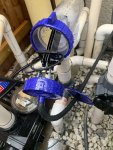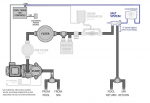I posted this a while back. residential in-deck pool SWG--do they exist anymore?
To followup, I just ended up caving in and buying a CircuPool inline cell. It was a downgrade--requires more salt and more energy to make it work. Also, a few months later, I find my pool mostly drained and the culprit being the cell plastic lid shattered, apparently do to over pressurization. I called, the retailer, they directed me to the factory. I waited on hold a lot, but and finally got somebody who seemed to accept this as a flaw, and agreed to send me a new unit. Long story short, I've waited 2 weeks, they are having warehouse issues and cannot get a unit out to me or even tell me when it will be resolved.
At this point, I'm re-lamenting the death of my AutoPilot Cubby which worked brilliantly for probalby 10 years and was just much better overall in design. I'd like to either find a new controller that would be compatible with this cell https://www.poolsupplyunlimited.com/pool/autopilot-400-5-cubby-salt-cell-replacement/56678p1---seems I just need an output of "3.0 Amps @ 10 – 16 VDC" . Could it really be so hard to produce a device that can generate this? Maybe I'm going to have to find a transformer and wire it up to a raspeberry Pi. The old controller was so simple, having just one small board, a transformer, and 1 knob. Old manual attached.
Anyway, I'm not really having much hope here, just wondering why there seems to be a lack of innovation in the SWG pool world and why manufacturers don't see the benefits of an in-deck solution.

To followup, I just ended up caving in and buying a CircuPool inline cell. It was a downgrade--requires more salt and more energy to make it work. Also, a few months later, I find my pool mostly drained and the culprit being the cell plastic lid shattered, apparently do to over pressurization. I called, the retailer, they directed me to the factory. I waited on hold a lot, but and finally got somebody who seemed to accept this as a flaw, and agreed to send me a new unit. Long story short, I've waited 2 weeks, they are having warehouse issues and cannot get a unit out to me or even tell me when it will be resolved.
At this point, I'm re-lamenting the death of my AutoPilot Cubby which worked brilliantly for probalby 10 years and was just much better overall in design. I'd like to either find a new controller that would be compatible with this cell https://www.poolsupplyunlimited.com/pool/autopilot-400-5-cubby-salt-cell-replacement/56678p1---seems I just need an output of "3.0 Amps @ 10 – 16 VDC" . Could it really be so hard to produce a device that can generate this? Maybe I'm going to have to find a transformer and wire it up to a raspeberry Pi. The old controller was so simple, having just one small board, a transformer, and 1 knob. Old manual attached.
Anyway, I'm not really having much hope here, just wondering why there seems to be a lack of innovation in the SWG pool world and why manufacturers don't see the benefits of an in-deck solution.



